Lately there has been some discussion about Brooks saddles in the comments sections of the posts. We have Brooks saddles on all six of our bicycles, and we have learned a lot about them. So I offer these notes for those riddled with indecision about which Brooks to get.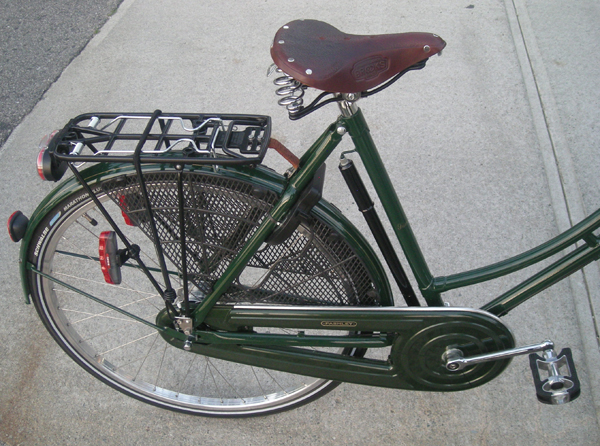 When choosing a Brooks saddle, there are really only two main factors to consider: width and spring. I will try to explain the role of each.
When choosing a Brooks saddle, there are really only two main factors to consider: width and spring. I will try to explain the role of each.
WIDTH
The basic rule is: The more upright your riding position (handlebars above saddle level), the wider your saddle needs to be. Brooks saddles come in several width categories.
For upright riding: The B72, B66, B67, B68, and B73 are all pretty much the same, generous width and are all appropriate for a an upright bicycle. Which one of them you will prefer depends on your preference for sprung vs unsprung saddles, and whether your bicycle has a modern or an old-style seat post (for example, the B66 and B67 are identical, except the latter is designed to fit modern seat posts).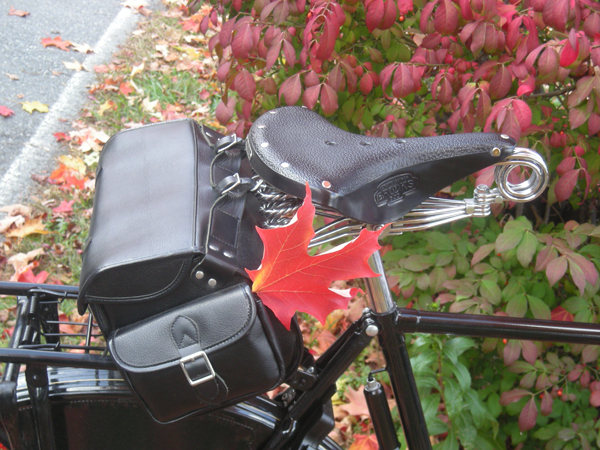 If you are heavier than 200lb and are riding a completely upright bicycle, you may want to consider the B33 or the B190. These are extra heavy-duty saddles and can take even the weightiest of riders on long upright trips.
If you are heavier than 200lb and are riding a completely upright bicycle, you may want to consider the B33 or the B190. These are extra heavy-duty saddles and can take even the weightiest of riders on long upright trips.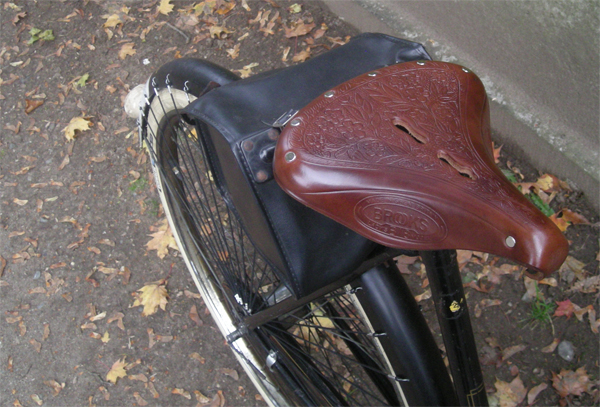 If you are female, love Edwardian design, and have a bicycle with very relaxed geometry, there is also the B18 "Lady". This is a very wide and short saddle, designed to be ridden by women wearing skirts and sitting completely upright on a bicycle with an extremely slack seat tube. See here for a detailed discussion of this saddle.
If you are female, love Edwardian design, and have a bicycle with very relaxed geometry, there is also the B18 "Lady". This is a very wide and short saddle, designed to be ridden by women wearing skirts and sitting completely upright on a bicycle with an extremely slack seat tube. See here for a detailed discussion of this saddle. For leaned-forward riding: If you are riding in a forward-leaning position so that your saddle is right at or above the level or your handlebars, in my opinion there are only two Brooks saddles to choose from unless you are a very aggressive cyclist: the B17 and the Flyer. These are in fact the same saddle, only the Flyer has springs and the B17 does not.
For leaned-forward riding: If you are riding in a forward-leaning position so that your saddle is right at or above the level or your handlebars, in my opinion there are only two Brooks saddles to choose from unless you are a very aggressive cyclist: the B17 and the Flyer. These are in fact the same saddle, only the Flyer has springs and the B17 does not.
In my view, all the other Brooks roadbike saddles (the B17 Narrow, the Team Pro, the Swift, and the Swallow) are too narrow for the majority cyclists who are likely to be reading this post. Many do not want to hear that, because those racing saddles often have the coolest aesthetics and come in all sorts of crazy colours and special editions. But cycling forums are full of people who bought the narrow saddle and are not able to ride them - either due to discomfort, or because the saddle falls apart under the rider's weight. The cycling style of a serious road cyclist is so aggressive, that their butt really only floats on the surface of the saddle, rather than actually sits upon it. That is what these saddles were designed for. If this does not describe your cycling style, I urge you to get a B17 or a Flyer.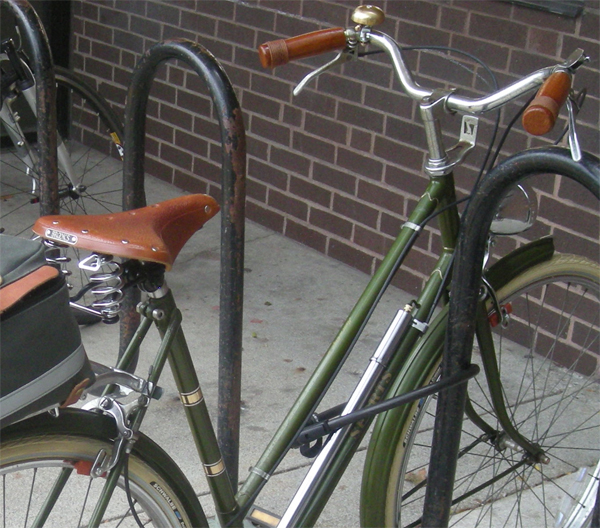 SPRINGS
SPRINGS
Sprung saddles provide suspension, the benefit of which is that you feel more comfortable going over bumps on the road. The drawback of suspension, is that you have less "control" over the ride. Which you prefer can be only decided via trial and error. For an upright bicycle, I would venture say that most cyclists tend to prefer the sprung saddles. For a more aggressive bike, it could go either way.
It is worth pointing out that not all sprung Brooks saddles are sprung equally. The B72 has minimal springs. The Flyer has larger coils, but they are very tight and provide a feeling of shock absorbtion rather than full spring. So if you are considering putting a Flyer on a roadbike but are worried that it may be too bouncy, it may not necessarily be the case. The B66-67 is generously sprung. The B33 and B190 are monstrously sprung, so choose these carefully. "MEN'S" vs. "WOMEN'S" SADDLES?...
"MEN'S" vs. "WOMEN'S" SADDLES?...
You may notice that many saddles are offered in a "woman's" version, where the saddle number is followed by the letter "S" (B66 vs B66S). I think this system is often misunderstood. The "S" stands for "short", and these saddles are simply shorter than their non-"S" counterparts - making them somewhat easier to mount and dismount while wearing a skirt without the skirt getting caught on the nose. I have ridden on both "S" and non-"S" saddles, and am still not sure whether the skirt-snagging difference is significant.
SPECIAL FINISHES
As for things like "Special," "Aged" and "Imperial" versions of the saddles, there is some debate whether they improve the saddle or not. The "Special" finish is more attractive and hardy than the regular finish, and features copper rivets. However, I and others have found saddles with the "Special" finish to be harder to break in. The "Aged" saddles are supposedly treated with some polymer, which some cyclists say improves their softness, while others say worsens it. And be careful choosing the "Imperial" versions of saddles, with cut-outs, because while some find those cut-outs helpful, others find them extremely painful. In short, my impression is that when in doubt it isa safer to go with standard finishes - unless you have a chance to try the saddle extensively.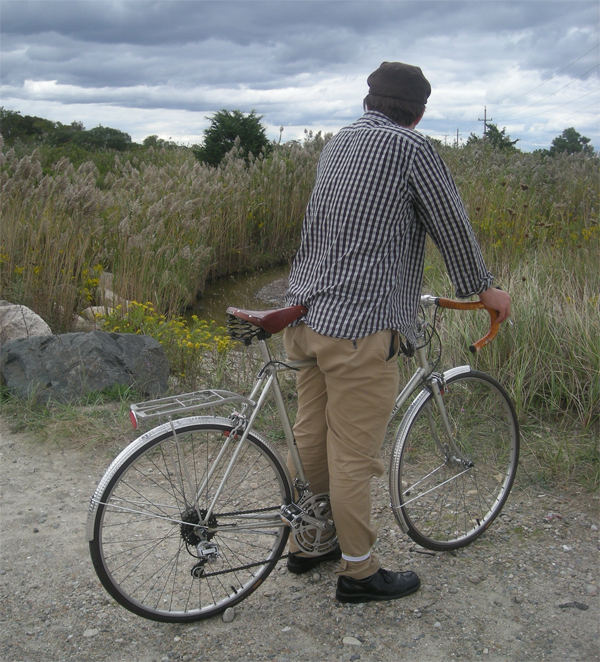 To summarise it all:
To summarise it all:
If you need an upright saddle, choose one of these. If you will be cycling in a forward-leaning position, choose one of these. And unless you are an aggressive road cyclist, stay away from these. Sprung vs unsprung, and "S" vs non-"S", are personal choices within each category. Of course in the end everybody is different, but I believe this summary is applicable in the majority of cases.
skip to main |
skip to sidebar
Blog Archive
-
▼
2009
(1637)
-
▼
October
(250)
- Friendly Witches and Scenic Graveyards
- Wairarapa A&P Show 2009
- Random Thoughts on Various Subjects
- Tom Fuller is Doing a Survey
- Dean Hood Model Part 4 - Coach, Wife and Kids
- Dean Hood Model Part 3 - Batttle the Extremes
- Important New Paper on North Atlantic Hurricanes
- Roger Pielke Sr. is Sure Going to Like This
- Made in Somerville: The Joys of a Locally Built Bi...
- The Problem with Exaggerated and Inaccurate Claims
- Should Bulgaria Pay Brazil?
- Blogs vs. MSM
- Pakistan's Coal
- Time for a bit of a root 'n scoot'n good time!
- Dean Hood Model Part 2-Acceptance Based Performance
- Player Leadership
- Keeping Prediction in Perspective
- Climate Whiplash
- Will William Connolley do the Right Thing?
- There is a fine line between being loved and being...
- Getting DVDs in the mailbox has replaced getting t...
- All-Weather Friend
- WEDNESDAY
- I'm not a Journalist, its just My Opinion
- Carrie Underwood Chooses Garth Brooks
- Hey Telfer, What will the ratings be like?
- Lomu the Liar
- I Don't Want You, But I Need You... When Bike Love...
- What is Graham's Bill?
- Dean Hood Model Part 1
- Do Pro Athletes Commit Crimes at Unusually High Ra...
- Have You Stepped on a Secular Religion?
- Blue collar jobs are dirty but honest. White colla...
- FIFA Changes the Rules
- He has a name
- Have I been Banned from Country Weekly???
- Tornado Losses in the United States
- Dean Hood Coaches Build Character
- Old English vs New English
- Navy's Backup QB
- Keith Kloor Blogging at Nature Climate Feedback
- Buzz Bissinger Op-Ed in today's New York Times on ...
- They are called my Lucky Pair of Underwear because...
- Mixed Messages
- Congratulations, it's a boy!
- Hey Fairfax, there's a Football match coming up?
- A Point Resolved in the Hockey Stick Wars
- Time Traveling
- An Inconvenient Comment
- How Much Future Hurricane Damage Can Stopping Glob...
- Gordn Ramsay is a Cartoon
- The Hohenkammer Consensus on Climate Change and Di...
- Paul Passafiume What is a Man
- Kairos Letter for a Friend
- Sports Law Blog's Joe Rosen Signs Red Sox Reliever...
- Media self-protection?
- Countdown to New Zealand Versus Bahrain
- RIAA Top Selling Male Artists of all time
- Meet the Face of Corruption
- Brooks Saddles: Demystifying the System
- Joe Romm's Latest 3,500 Words on Me
- Paul Passafiume Virtue=Strength
- Email from former player
- Random Thoughts on Various Subjects
- Godspeed, Lucy 3-Speed!
- I believe in equal rights for all women especially...
- Paul Passafiume Culture of Lies
- LSU Baseball Coach Interview
- President Obama's MIT Speech
- A great way to solve problems is to bitch and whin...
- Steve Rayner Speaking Today at CIRES!
- Japan Lays Groundwork for a Stepback
- Two Views of BAU in China
- IPCC Chief Criticizes President Obama
- Hey Telfer, we have a Gym too
- The "Lady" Finds a Home! (Thoughts on the Brooks ...
- A Coach Reaches out to former players
- Public Opinion Realities
- Sports Law Discussion today at Harvard Law School
- Elephant in the Negotiations
- There is no greater gift than a Walmart gift card....
- If Tomorrow Never Comes
- Moles has to go
- Minto Wrong Again
- Ladies' Bicycles from ANT: 2 Test Rides
- Greenpeace: Optimists, Apologists, Opposition and ...
- Post-Doc Wanted
- HAPPY BIRTHDAY, TYLER ROARK!!! (She is 16. OLD WOM...
- Gerrry Faust - How to Build Confidence in Players
- Sports Implications of the Genetic Information Non...
- IPCC Advocate in Chief
- I'm pooped so this will be brief ...
- It's Beginning to Look a Lot Like Xmas
- Limbaugh Attacks Andy Revkin
- Faith, football and a fatherly instinct
- Mensa is a way for brilliant failures to salvage t...
- Giant Fish, Big Fish and Minnows of the Liberal Bl...
- Raleigh DL-1 Restoration!
- MMP to Go, We Live in Hope
- My Denier Credentials Exposed
-
▼
October
(250)
Popular Posts
-
After a little over a week since 48 players exchanged numbers with their teams, and according to my research 13 players have signed if you i...
-
This is my opening post on my blog. This blog is going to be about the Media/ Sports/Music/Politicans. I hope ya'all find it interestin...
-
I am going ahead with the idea of facilitating barter exchanges between readers, chosing the old-school method in the interest of simplicit...
-
Male porn stars are famous for their above average endowments. Ron Jeremy is measured at 9.75 inches. Another famous porn star was John Holm...
-
I take what I call a journalistic interest in a variety of sports. If I didn't write, I wouldn't waste my time learning about them. ...
-
Paula Radcliffe is a distance runner who hails from Britain. She is the first woman to ever go below 2:20 for the marathon redefining what w...
-
Today's FT has a special report on Nigeria, and has a very interesting discussion of energy access : Despite average cash injections of...
-
Just wanted to thank everyone who has been apart, visited or entered our contests on this blog and help us get to 30,000. It's not quite...
Copyright © 2011 Sport News Update | Powered by Blogger
Design by Free WordPress Themes | Bloggerized by Lasantha - Premium Blogger Themes | Website Value Calculation Tool





2 comments:
golden goose outlet
jordans
yeezy boost 350
birkin bag
curry 7 shoes
golden goose starter
yeezy outlet
curry shoes
golden goose outlet
yeezy
Extra resources replica louis vuitton you could try these out high replica bags Read Full Report replica designer bags wholesale
Post a Comment